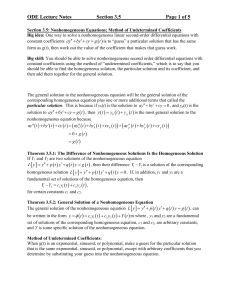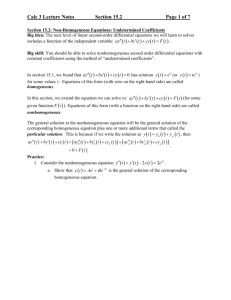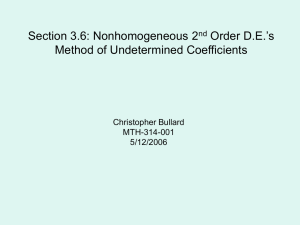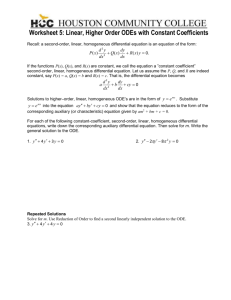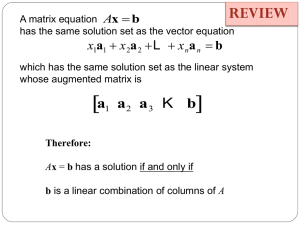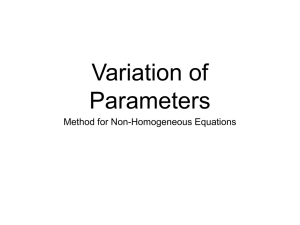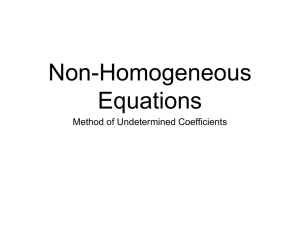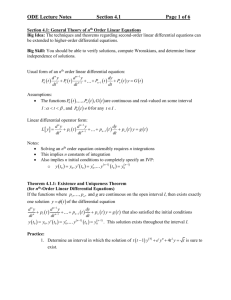Lecture Notes for Section 3.5
advertisement
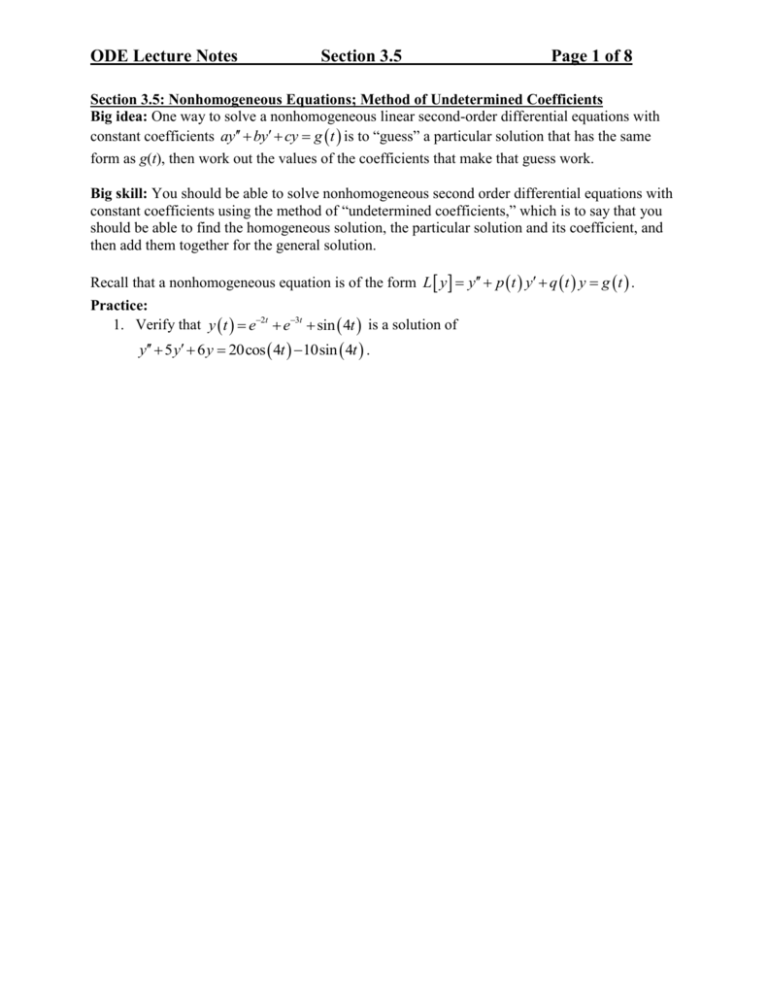
ODE Lecture Notes Section 3.5 Page 1 of 8 Section 3.5: Nonhomogeneous Equations; Method of Undetermined Coefficients Big idea: One way to solve a nonhomogeneous linear second-order differential equations with constant coefficients ay by cy g t is to “guess” a particular solution that has the same form as g(t), then work out the values of the coefficients that make that guess work. Big skill: You should be able to solve nonhomogeneous second order differential equations with constant coefficients using the method of “undetermined coefficients,” which is to say that you should be able to find the homogeneous solution, the particular solution and its coefficient, and then add them together for the general solution. Recall that a nonhomogeneous equation is of the form L y y p t y q t y g t . Practice: 1. Verify that y t e2t e3t sin 4t is a solution of y 5 y 6 y 20cos 4t 10sin 4t . ODE Lecture Notes Section 3.5 Page 2 of 8 The general solution to the nonhomogeneous equation will be the general solution of the corresponding homogeneous equation (i.e., L y 0 ) plus one or more additional terms called the particular solution. This is because if yh(t) is the solution to ay by cy 0 , and yp(t) is the solution to ay by cy g t , then y t yh t y p t is the most general solution to the nonhomogeneous equation because ay t by t cy t ayh t byh t cyh t ay p t by p t cy p t 0 g t g t Theorem 3.5.1: The Difference of Nonhomogeneous Solutions Is the Homogeneous Solution If Y1 and Y2 are two solutions of the nonhomogeneous equation L y y p t y q t y g t , then their difference Y1 Y2 is a solution of the corresponding homogeneous solution L y y p t y q t y 0 . If, in addition, y1 and y2 are a fundamental set of solutions of the homogeneous equation, then Y1 Y2 c1 y1 t c2 y2 t , for certain constants c1 and c2. Theorem 3.5.2: General Solution of a Nonhomogeneous Equation The general solution of the nonhomogeneous equation L y y p t y q t y g t , can be written in the form y t c1 y1 t c2 y2 t Y t where y1 and y2 are a fundamental set of solutions of the corresponding homogeneous equation, c1 and c2, are arbitrary constants, and Y is some specific solution of the nonhomogeneous equation. Method of Undetermined Coefficients: When g(t) is an exponential, sinusoid, or polynomial, make a guess for the particular solution that is the same exponential, sinusoids of the same frequency, or polynomial of the same degree, except with arbitrary coefficients that you determine by substituting your guess into the nonhomogeneous equation. This technique works because derivatives of these types of functions result in the same type of function. If the form for the particular solution replicates any terms of the homogeneous solution, then factors of t must be applied until there is no replication. ODE Lecture Notes Section 3.5 Page 3 of 8 Forms for the Particular Solution of ay by cy g t for Assorted g(t): g t Pn t (i.e., a polynomial of degree n) y p t Qn t (i.e., a polynomial of degree n, but with different coefficients than Pn) Exception #1: r = 0 is a root of the homogeneous equation y p t t Qn t g t A cost B sin t Exception #2: r = 0 is a double root of the homogeneous equation y p t t 2 Qn t y p t C1 cost C 2 sin t Exception: r = ± are roots of the homogeneous equation y p t C1t cost C 2 t sin t g t A e kt y p t C1e kt Exception #1: r = k is a root of the homogeneous equation y p t C1tekt Exception #2: r = k is a double root of the homogeneous equation y p t C1t 2 e kt g t ekt Pn t y p t Qn t ekt (i.e., the product of a polynomial of degree n, and an exponential). Exception #1: r = k is a root of the homogeneous equation y p t tQn t ekt Exception #2: r = k is a double root of the homogeneous equation y p t t 2Qn t ekt g t ekt A cos t B sin t g t Pn t cos t sin t y p t ekt C1 cos t C2 sin t Exception #1: r = k + i is a root of the homogeneous equation y p t tekt C1 cos t C2 sin t ODE Lecture Notes Section 3.5 Page 4 of 8 Practice: 2. Find the general solution for y 2t 3 by direct integration and by the method of undetermined coefficients. ODE Lecture Notes Section 3.5 3. Solve the IVP y t y t 2 y t 2e3t , y(0) = 1, y’(0) = 1. Page 5 of 8 ODE Lecture Notes Section 3.5 4. Solve the IVP y t y t 2 y t 2sin t , y(0) = 1, y’(0) = 1. Page 6 of 8 ODE Lecture Notes Section 3.5 5. Solve the IVP y t y t 2 y t 2et sin t , y(0) = 1, y’(0) = 1. Page 7 of 8 ODE Lecture Notes Section 3.5 6. Solve the IVP y t y t 2 y t 2et , y(0) = 1, y’(0) = 1. Page 8 of 8
